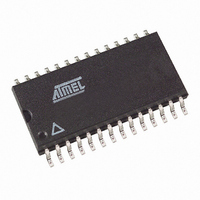T89C5115-TISIM Atmel, T89C5115-TISIM Datasheet - Page 14

T89C5115-TISIM
Manufacturer Part Number
T89C5115-TISIM
Description
IC 8051 MCU FLASH 16K 28SOIC
Manufacturer
Atmel
Series
89Cr
Datasheet
1.T89C5115-RATIM.pdf
(113 pages)
Specifications of T89C5115-TISIM
Core Processor
8051
Core Size
8-Bit
Speed
40MHz
Connectivity
UART/USART
Peripherals
POR, PWM, WDT
Number Of I /o
20
Program Memory Size
16KB (16K x 8)
Program Memory Type
FLASH
Eeprom Size
2K x 8
Ram Size
512 x 8
Voltage - Supply (vcc/vdd)
3 V ~ 5.5 V
Data Converters
A/D 8x10b
Oscillator Type
Internal
Operating Temperature
-40°C ~ 85°C
Package / Case
28-SOIC (7.5mm Width)
Lead Free Status / RoHS Status
Contains lead / RoHS non-compliant
- Current page: 14 of 113
- Download datasheet (2Mb)
Clock
Description
14
AT89C5115
The T89C5115 core needs only 6 clock periods per machine cycle. This feature, called
“X2”, provides the following advantages:
•
•
•
•
In order to keep the original C51 compatibility, a divider-by-2 is inserted between the
XTAL1 signal and the main clock input of the core (phase generator). This divider may
be disabled by the software.
An extra feature is available to start after Reset in the X2 Mode. This feature can be
enabled by a bit X2B in the Hardware Security Byte. This bit is described in the section
’In-System Programming’.
The X2 bit in the CKCON register (See Table 11) allows switching from 12 clock cycles
per instruction to 6 clock cycles and vice versa. At reset, the standard speed is activated
(STD mode).
Setting this bit activates the X2 feature (X2 Mode) for the CPU Clock only (See Figure
3).
The Timers 0, 1 and 2, Uart, PCA, or watchdog switch in X2 Mode only if the corre-
sponding bit is cleared in the CKCON register.
The clock for the whole circuit and peripheral is first divided by two before being used by
the CPU core and peripherals. This allows any cyclic ratio to be accepted on the XTAL1
input. In X2 Mode, as this divider is bypassed, the signals on XTAL1 must have a cyclic
ratio between 40 to 60%. Figure 3. shows the clock generation block diagram. The X2
bit is validated on the XTAL1 ÷ 2 rising edge to avoid glitches when switching from the
X2 to the STD mode. Figure 4 shows the mode switching waveforms.
Divides frequency crystals by 2 (cheaper crystals) while keeping the same CPU
power.
Saves power consumption while keeping the same CPU power (oscillator power
saving).
Saves power consumption by dividing dynamic operating frequency by 2 in
operating and idle modes.
Increases CPU power by 2 while keeping the same crystal frequency.
4128G–8051–02/08
Related parts for T89C5115-TISIM
Image
Part Number
Description
Manufacturer
Datasheet
Request
R

Part Number:
Description:
IC 8051 MCU FLASH 16K 32VQFP
Manufacturer:
Atmel
Datasheet:

Part Number:
Description:
IC 8051 MCU FLASH 16K 28SOIC
Manufacturer:
Atmel
Datasheet:

Part Number:
Description:
IC 8051 MCU FLASH 16K 28PLCC
Manufacturer:
Atmel
Datasheet:

Part Number:
Description:
IC 8051 MCU FLASH 16K 24SOIC
Manufacturer:
Atmel
Datasheet:

Part Number:
Description:
Low Pin Count 8-bit MCU with A/D Converter and 16-Kbytes of Flash Memory
Manufacturer:
ATMEL Corporation
Datasheet:

Part Number:
Description:
DEV KIT FOR AVR/AVR32
Manufacturer:
Atmel
Datasheet:

Part Number:
Description:
INTERVAL AND WIPE/WASH WIPER CONTROL IC WITH DELAY
Manufacturer:
ATMEL Corporation
Datasheet:

Part Number:
Description:
Low-Voltage Voice-Switched IC for Hands-Free Operation
Manufacturer:
ATMEL Corporation
Datasheet:

Part Number:
Description:
MONOLITHIC INTEGRATED FEATUREPHONE CIRCUIT
Manufacturer:
ATMEL Corporation
Datasheet:

Part Number:
Description:
AM-FM Receiver IC U4255BM-M
Manufacturer:
ATMEL Corporation
Datasheet:

Part Number:
Description:
Monolithic Integrated Feature Phone Circuit
Manufacturer:
ATMEL Corporation
Datasheet:

Part Number:
Description:
Multistandard Video-IF and Quasi Parallel Sound Processing
Manufacturer:
ATMEL Corporation
Datasheet:










